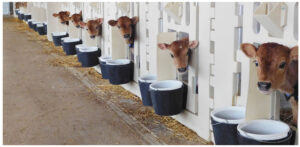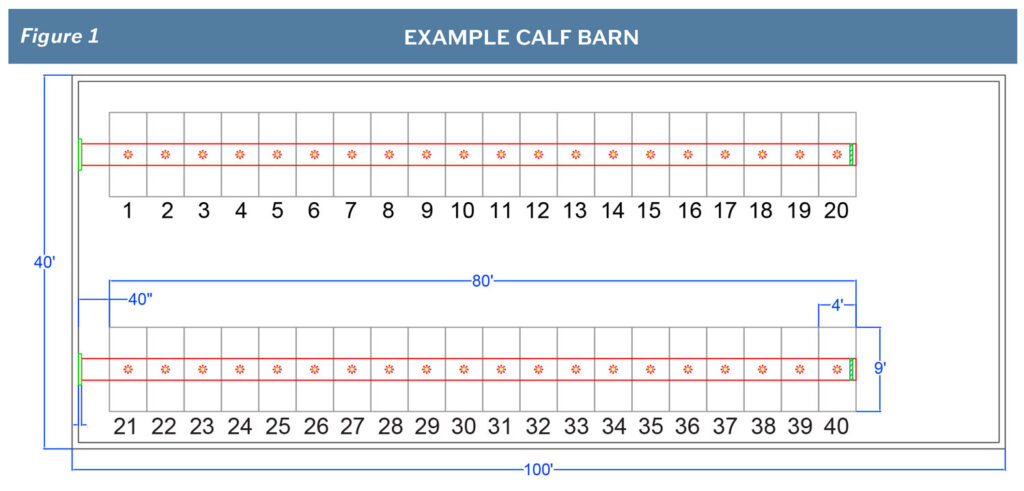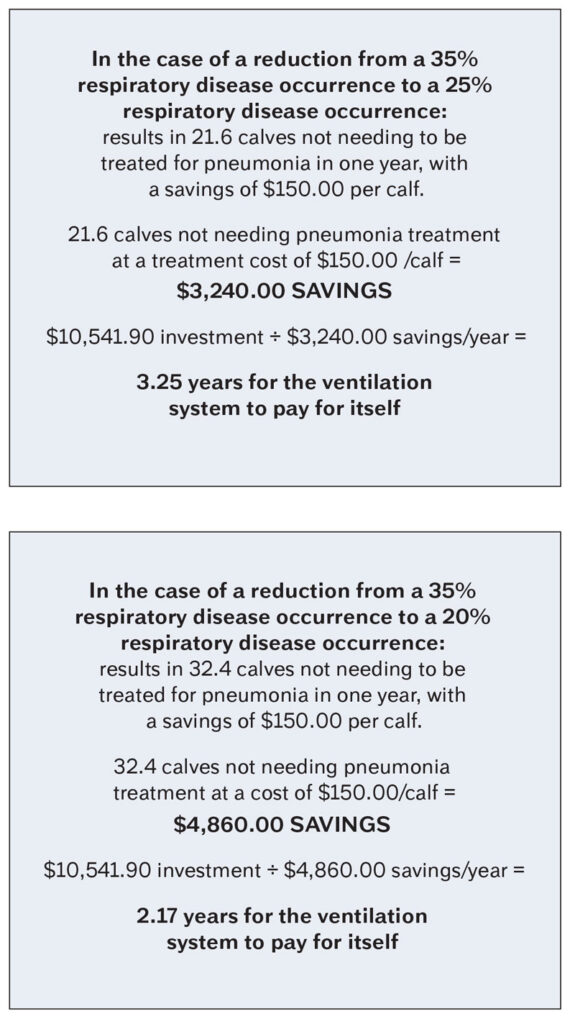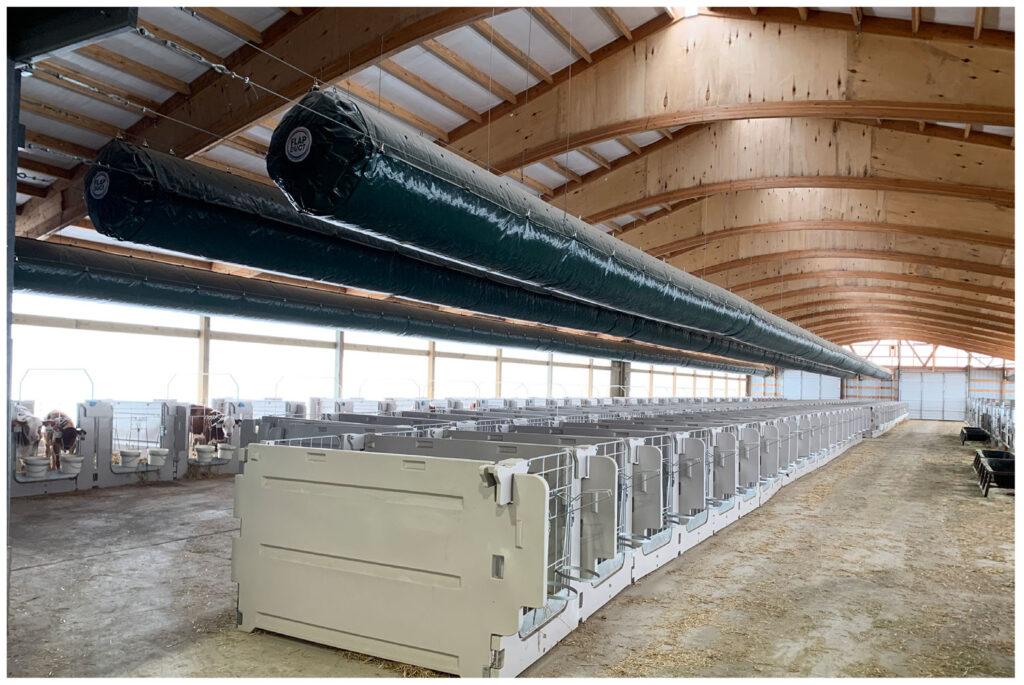The ROI of Calf Barn Ventilation
Click here to view as a pdf: The ROI of Calf Barn Ventilation.
One of the top expenses for a dairy is raising replacement heifers. Since it can take approximately two years before a heifer enters the milking herd, heifer raising is often viewed as a cost rather than an investment. While producers may consider cutting corners on heifer care as an attempt to save money, that approach can often lead to greater financial loss in the form of additional medical treatments, increased farm labor, and poor animal performance. Future milk production potential should also be considered. Studies have shown that calves who receive proper care during the pre- and post-weaning periods become better-producing cows. A better-producing cow means a faster return on investment and increased profit. Investing in practices that will help provide a healthy environment for calves to be raised in will result in more productive animals once maturity is reached. There are many variables of calf care, from different feeding programs to housing styles. This article will focus on the cost, and the return on investment, of proper air quality provided by positive pressure calf barn ventilation systems.
 The Economic Impact of Calfhood Pneumonia
The Economic Impact of Calfhood Pneumonia
In order to evaluate the economic impact of calfhood pneumonia, a farm’s average pneumonia case cost, and frequency of occurrence, need to be determined. It is important to note that for this evaluation, we will only be considering pneumonia cases that are caused by environmental factors (which can be addressed by improving air quality). Pneumonia can also be caused by contagious sources. For more information on the differences between environmental and contagious pneumonia, refer to the August 2020 issue of the Crystal Creek® Newsletter, “Calfhood Pneumonia: When Is It Related to Ventilation and When Is It Something Different?” by Dr. Ryan Leiterman. To help simplify the number of variables that can be involved in calf barn ventilation evaluations, this article will focus on one aspect that a positive pressure tube ventilation system provides: the economic impact of environmental calfhood pneumonia in pre-weaned calves.
First, an economic loss per case of calfhood pneumonia must be established. Dr. Kevin Dhuyvetter, along with Dr. Michael Overton, conducted a study in 2021 on 23 herds which included a total of 104,000 calves.
Their study suggested a potential cost ranging from $212 to $237 per pneumonia case. Another study done by Texas A&M found heifers that experienced respiratory disease not only took longer to enter the milking herd, but also produced 2.4 lb. of milk less than heifers that did not experience respiratory disease. Similar studies have found ranges of 125 lb. to over 400 lb. less milk produced in first lactation for heifers that experienced pneumonia. When considering potential milk production loss alone, the economic loss can range from $25 to over $100 per heifer depending on the current milk price.
The Dairy Calf & Heifer Association Gold Standards target a respiratory disease rate occurrence of <10% in pre-weaned calves. In May 2020, the Dairy Calf & Heifer Association (DCHA) webinar featuring Dr. Kevin Dhuyvetter presented information from a study with Dr. Dhuyvetter and Dr. Overton which found the average occurrence of pneumonia was 37.2% during the first 150 to 200 days of life. This occurrence is well above the recommended DCHA standard of <10%. For the purposes of this article’s projections, a pneumonia rate of 35% will be used.
Using the approximate cost and level of occurrences previously mentioned, this article will now apply these factors to a real-life example that demonstrates the return on investment for a FLAP DUCT® calf barn ventilation system. It is important to note that a properly sized and placed positive-pressure ventilation tube with appropriate air speeds will provide more benefits than just improved air quality. Heat abatement in the summer, relief from fly pressure during warmer seasons and even keeping bedding drier are all additional assets of a properly designed ventilation system. Each one of these factors can have an economic impact on calf health and performance above and beyond the calculations in this article.
Figure 1 shows an example barn of 40’x100’. The barn can house 40 calves in individual pens with 20 pens on each side. In this cost analysis, a 28” x 84’ FLAP DUCT® positive pressure ventilation tube is placed over each row, resulting in a total system cost of $10,541.90.
Proving the Return on Investment
By installing a properly designed ventilation system that meets ventilation requirements for all four seasons, this example will assume pneumonia rates were reduced to the DCHA Gold Standards of <10%. Calves in this barn have a 60-day weaning age. If calves remain in these pens for approximately a week after weaning, before transitioning to a post-weaned barn, they will be housed in these pens for approximately 67 days. This allows for 5.4 groups of calves to be housed in this facility in 1 year.
40 calves/group x 5.4 groups/year = 216 calves/year
Other Pneumonia Occurrence Rates
Calf raisers that install a ventilation system may not all see a pneumonia rate drop to an occurrence of <10%, but any rate of reduction is a cost savings. To show the return on investment in other scenarios, the same calculations that were applied to a pneumonia rate decrease from 35% to 10% will now be applied to a 25%, 20%, and 15% pneumonia rate occurrence.
The FLAP DUCT® ventilation system has currently been in barns for well over 10 years. It is important to remember this estimated return on investment was calculated with respect to only one aspect or benefit of the FLAP DUCT® system. The savings incurred in this one-year time frame could be even greater in subsequent years as time progresses. A properly designed ventilation system will address fly pressure, heat stress, bedding moisture, and more. All things in addition to improved air quality and will provide an even faster ROI.
No matter what type of pen style or calf barn housing setup you have, the FLAP DUCT® system can deliver consistent, fresh air to your calves. Before considering cutting costs on a ventilation system that is undersized or that underperforms, consider the bigger picture and the long-term impact it will have. To learn more about how the FLAP DUCT® calf barn ventilation system can work in your barn, visit www.crystalcreeknatural.com.
References available upon request.






